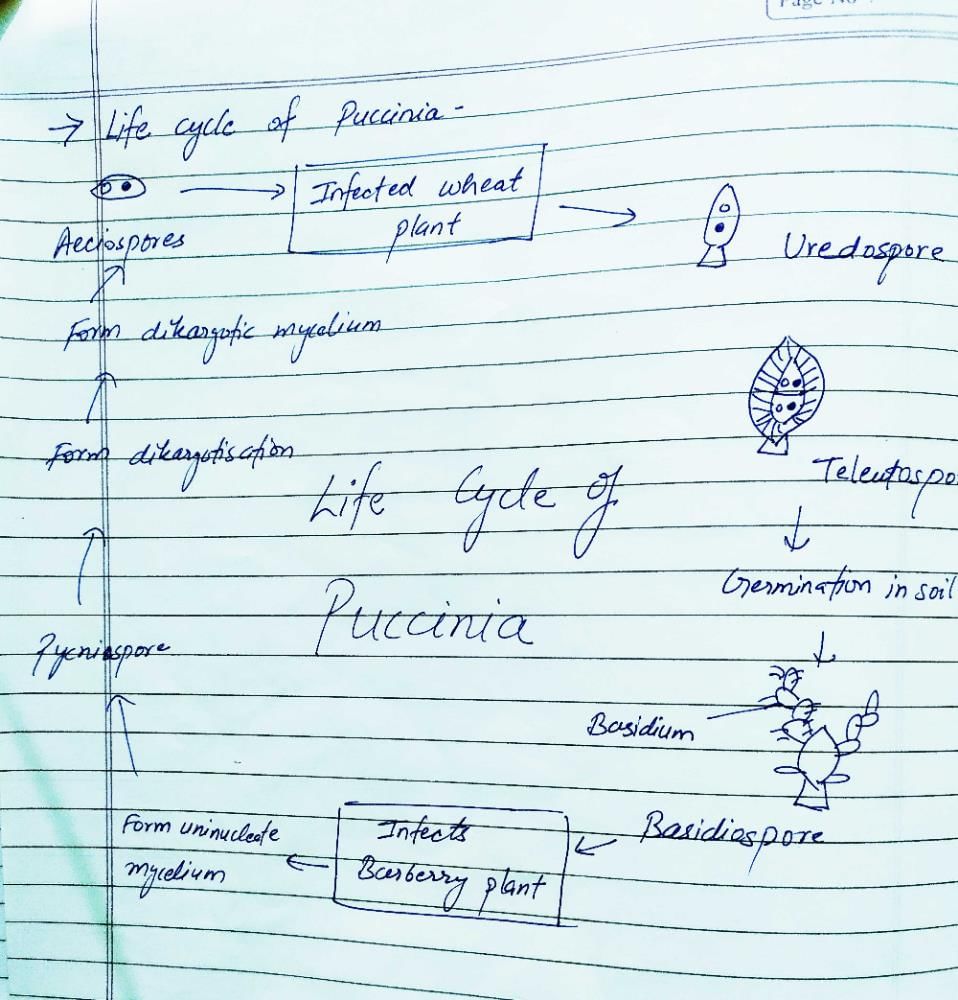NEET Exam > NEET Questions > Please explain life cycle of puccinia( wheat ...
Start Learning for Free
Please explain life cycle of puccinia( wheat and berberry)? -better to explain through flow chart attachment?
Most Upvoted Answer
Please explain life cycle of puccinia( wheat and berberry)? -better to...

Community Answer
Please explain life cycle of puccinia( wheat and berberry)? -better to...
Life Cycle of Puccinia (Wheat and Berberry)
1. Infection of Wheat Plant
- The life cycle of Puccinia begins when its spores land on a wheat plant.
- The spores germinate and produce thread-like structures called germ tubes that penetrate the plant's tissues.
- The fungus then forms specialized structures called haustoria, which extract nutrients from the plant.
2. Formation of Teliospores
- As the infection progresses, Puccinia forms teliospores in the wheat plant.
- These teliospores are dark-colored and resistant to harsh environmental conditions.
3. Release and Spread of Teliospores
- The teliospores are released from the infected wheat plant and spread through the air.
- They can land on nearby berberry plants, which serve as an alternate host for Puccinia.
4. Infection of Berberry Plant
- When the teliospores land on a berberry plant, they germinate and infect the plant.
- The fungus goes through a similar cycle of forming germ tubes, haustoria, and ultimately teliospores on the berberry plant.
5. Formation of Basidiospores
- On the berberry plant, Puccinia forms basidiospores instead of teliospores.
- These basidiospores are then released and spread to nearby wheat plants, completing the life cycle of Puccinia.
Through this complex life cycle involving both wheat and berberry plants, Puccinia is able to survive and spread, causing potential damage to wheat crops. Proper management strategies are essential to control the spread of this fungal pathogen and protect wheat yields.
1. Infection of Wheat Plant
- The life cycle of Puccinia begins when its spores land on a wheat plant.
- The spores germinate and produce thread-like structures called germ tubes that penetrate the plant's tissues.
- The fungus then forms specialized structures called haustoria, which extract nutrients from the plant.
2. Formation of Teliospores
- As the infection progresses, Puccinia forms teliospores in the wheat plant.
- These teliospores are dark-colored and resistant to harsh environmental conditions.
3. Release and Spread of Teliospores
- The teliospores are released from the infected wheat plant and spread through the air.
- They can land on nearby berberry plants, which serve as an alternate host for Puccinia.
4. Infection of Berberry Plant
- When the teliospores land on a berberry plant, they germinate and infect the plant.
- The fungus goes through a similar cycle of forming germ tubes, haustoria, and ultimately teliospores on the berberry plant.
5. Formation of Basidiospores
- On the berberry plant, Puccinia forms basidiospores instead of teliospores.
- These basidiospores are then released and spread to nearby wheat plants, completing the life cycle of Puccinia.
Through this complex life cycle involving both wheat and berberry plants, Puccinia is able to survive and spread, causing potential damage to wheat crops. Proper management strategies are essential to control the spread of this fungal pathogen and protect wheat yields.
Attention NEET Students!
To make sure you are not studying endlessly, EduRev has designed NEET study material, with Structured Courses, Videos, & Test Series. Plus get personalized analysis, doubt solving and improvement plans to achieve a great score in NEET.

|
Explore Courses for NEET exam
|

|
Similar NEET Doubts
Please explain life cycle of puccinia( wheat and berberry)? -better to explain through flow chart attachment?
Question Description
Please explain life cycle of puccinia( wheat and berberry)? -better to explain through flow chart attachment? for NEET 2024 is part of NEET preparation. The Question and answers have been prepared according to the NEET exam syllabus. Information about Please explain life cycle of puccinia( wheat and berberry)? -better to explain through flow chart attachment? covers all topics & solutions for NEET 2024 Exam. Find important definitions, questions, meanings, examples, exercises and tests below for Please explain life cycle of puccinia( wheat and berberry)? -better to explain through flow chart attachment?.
Please explain life cycle of puccinia( wheat and berberry)? -better to explain through flow chart attachment? for NEET 2024 is part of NEET preparation. The Question and answers have been prepared according to the NEET exam syllabus. Information about Please explain life cycle of puccinia( wheat and berberry)? -better to explain through flow chart attachment? covers all topics & solutions for NEET 2024 Exam. Find important definitions, questions, meanings, examples, exercises and tests below for Please explain life cycle of puccinia( wheat and berberry)? -better to explain through flow chart attachment?.
Solutions for Please explain life cycle of puccinia( wheat and berberry)? -better to explain through flow chart attachment? in English & in Hindi are available as part of our courses for NEET.
Download more important topics, notes, lectures and mock test series for NEET Exam by signing up for free.
Here you can find the meaning of Please explain life cycle of puccinia( wheat and berberry)? -better to explain through flow chart attachment? defined & explained in the simplest way possible. Besides giving the explanation of
Please explain life cycle of puccinia( wheat and berberry)? -better to explain through flow chart attachment?, a detailed solution for Please explain life cycle of puccinia( wheat and berberry)? -better to explain through flow chart attachment? has been provided alongside types of Please explain life cycle of puccinia( wheat and berberry)? -better to explain through flow chart attachment? theory, EduRev gives you an
ample number of questions to practice Please explain life cycle of puccinia( wheat and berberry)? -better to explain through flow chart attachment? tests, examples and also practice NEET tests.

|
Explore Courses for NEET exam
|

|
Suggested Free Tests
Signup for Free!
Signup to see your scores go up within 7 days! Learn & Practice with 1000+ FREE Notes, Videos & Tests.

























